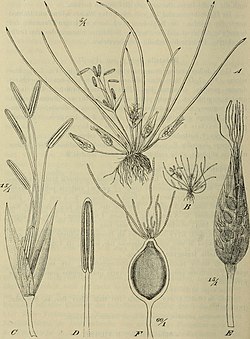Hydatellaceae
| Hydatellaceae | ||
|---|---|---|
 | ||
| Taxonomía | ||
| Reino: | Plantae | |
| División: | Magnoliophyta | |
| Clase: | Liliopsida | |
| Subclase: | Commelinidae | |
| Orden: | Nymphaeales | |
| Familia: |
Hydatellaceae (familia n.º 2 en LAPG III 2009[1]) U.Hamann (1976) | |
| Géneros | ||
Ver texto | ||
Hydatellaceae es una familia de plantas acuáticas de Australasia y la India. La familia fue reconocida por sistemas de clasificación modernos como el sistema de clasificación APG III (2009[2]) y el APWeb (2001 en adelante[3]) que la asignan al orden Nymphaeales.
Descripción
[editar]Son plantas acuáticas. Las hojas son simples concentradas alrededor de un corto tallo basal. La planta está sumergida y emergen del agua anualmente, las raíces permanecen bajo el agua en el substrato. Las plantas son hidrófilas. Las flores se encuentran en racimos. Los frutos son aquenios.[4]
Ecología
[editar]Se encuentran solamente en Australasia y la India.
Filogenia
[editar]- Introducción teórica en Filogenia
Hydatellaceae fue por muchos años considerada cercana a Poales, así como también de la incluyó en Centrolepidaceae. No obstante, los estudios filogenéticos han demostrado que se halla incluida dentro de Nymphaeales y, por lo tanto, representa uno de los más antiguos linajes de angiospermas.[5]
Taxonomía
[editar]- Introducción teórica en Taxonomía
La familia fue reconocida por el APG III (2009[2]), el Linear APG III (2009[1]) le asignó el número de familia 2. La familia ya había sido reconocida por el APG II (2003[6]) si bien en otro orden.
2 géneros:
- Hydatella, ahora incluido en Trithuria
- Trithuria
Referencias
[editar]- ↑ a b Elspeth Haston, James E. Richardson, Peter F. Stevens, Mark W. Chase, David J. Harris. The Linear Angiosperm Phylogeny Group (LAPG) III: a linear sequence of the families in APG III Botanical Journal of the Linnean Society, Vol. 161, No. 2. (2009), pp. 128-131. doi:10.1111/j.1095-8339.2009.01000.x Key: citeulike:6006207 pdf: http://onlinelibrary.wiley.com/doi/10.1111/j.1095-8339.2009.01000.x/pdf
- ↑ a b The Angiosperm Phylogeny Group III ("APG III", en orden alfabético: Brigitta Bremer, Kåre Bremer, Mark W. Chase, Michael F. Fay, James L. Reveal, Douglas E. Soltis, Pamela S. Soltis y Peter F. Stevens, además colaboraron Arne A. Anderberg, Michael J. Moore, Richard G. Olmstead, Paula J. Rudall, Kenneth J. Sytsma, David C. Tank, Kenneth Wurdack, Jenny Q.-Y. Xiang y Sue Zmarzty) (2009). «An update of the Angiosperm Phylogeny Group classification for the orders and families of flowering plants: APG III.» (pdf). Botanical Journal of the Linnean Society (161): 105-121. Archivado desde el original el 25 de mayo de 2017. Consultado el 16 de mayo de 2010.
- ↑ Stevens, P. F. (2001 en adelante). «Angiosperm Phylogeny Website (Versión 9, junio del 2008, y actualizado desde entonces)» (en inglés). Consultado el 12 de enero de 2009.
- ↑ T.D. Macfarlane, L. Watson and N.G. Marchant (Editors) (2000 onwards). Western Australian Genera and Families of Flowering Plants. Western Australian Herbarium. Version: August 2002. FloraBase: Hydatellaceae Archivado el 14 de julio de 2007 en Wayback Machine.. Accessed 20 March 2007.
- ↑ Saarela, Jeffery M., Hardeep S. Rai, James A. Doyle, Peter K. Endress, Sarah Mathews, Adam D. Marchant, Barbara G. Briggs & Sean W. Graham. 2007. Hydatellaceae identified as a new branch near the base of the angiosperm phylogenetic tree. Nature 446:312-315.
- ↑ APG II (2003). «An Update of the Angiosperm Phylogeny Group Classification for the orders and families of flowering plants: APG II.» (pdf). Botanical Journal of the Linnean Society (141): 399-436. Consultado el 12 de enero de 2009. (enlace roto disponible en Internet Archive; véase el historial, la primera versión y la última).
Enlaces externos
[editar]- Hydatellaceae Archivado el 24 de abril de 2006 en Wayback Machine. in L. Watson and M.J. Dallwitz (1992 onwards). The families of flowering plants Archivado el 3 de enero de 2007 en Wayback Machine.: descriptions, illustrations, identification, information retrieval. Version: 27th April 2006. http://delta-intkey.com Archivado el 3 de enero de 2007 en Wayback Machine..
- Hydatellaceae photographs
- Hydatellela in western Australia
- Trithuria in western Australia
- NCBI Taxonomy Browser
- links at CSDL Archivado el 1 de diciembre de 2008 en Wayback Machine.
Text is available under the CC BY-SA 4.0 license; additional terms may apply.
Images, videos and audio are available under their respective licenses.
